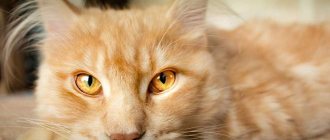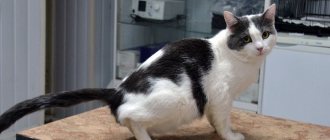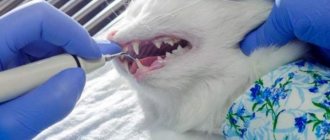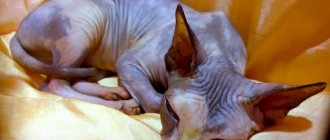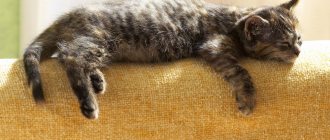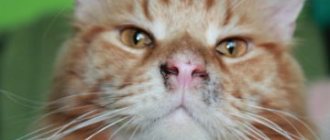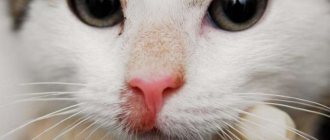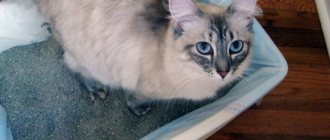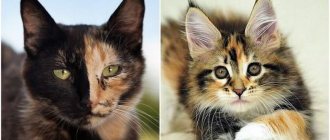Mastitis is a pathology that brings many difficulties not only to the sick animal, but also to its owners. In the absence of high-quality therapeutic intervention in the initial stages, the disease is complicated by the appearance of neoplasms of various types, the death of the pet from severe intoxication and general infection of the body by pathogens entering the bloodstream, or the death of kittens as a result of food poisoning. By what signs can you tell that a cat’s mammary glands are inflamed, what to do if a pathological process occurs and how to prevent it?
General information about the disease
Mastitis is an infectious and inflammatory lesion of the mammary glands. Most often found in lactating cats. The pathology can be unilateral or bilateral and, in the absence of urgent and adequate treatment, can lead to the death of the animal.
Bilateral multiple mastitis
Causes of mastitis in cats
global $ads_google; //data-ad-slot=”2475549904″ $ads_google = empty($ads_google) ? false : true; ?> if ($ads_google == false) {?>
$ads_google = true; ?> } ?>
Factors that initiate mammary gland pathology can be very different. They concern both the physiology of the animal itself and environmental conditions. The claim that mastitis only occurs in lactating cats and does not occur in cats that have been neutered is a misconception. Practice shows that mastitis occurs in cats in any condition. Precipitating conditions include:
- Injuries, mechanical irritation in the gland area.
- Infection of tissues through cracks in the nipples.
- Gynecological and urological diseases.
- Stagnation of milk due to early weaning of kittens from their mother.
- Blockage of the milk ducts for physiological reasons.
- Stillbirth of cubs in the same litter.
- Complications after cesarean section.
- Violation of hormone synthesis during estrus, false pregnancy.
The development of mastitis in cats is facilitated by hypothermia and a weakened immune system.
Reasons for appearance
Many factors have been identified that lead to the occurrence of this disease, among them the following should be noted:
- increased production of breast milk . Very often there are situations when the secretion of the mammary glands is not removed in a timely manner. Against the background of prolonged stagnation, infection and the occurrence of an inflammatory process occur. The reasons for the lack of milk excretion may be: early separation of mother and children (it is recommended to take small animals away from the cat no earlier than 2-3 months after birth), aggressive behavior of a pet towards cubs, various diseases of kittens;
- hypothermia of the mammary glands . Spending a long time on the street in winter, lying on cold tiles, living in conditions of a constant draft or air conditioning reduces the local and general protection factors of the cat and leads to the development of an infectious and inflammatory process in the glands;
- failure to use all nipples . In some cases, certain nipples are not used by kittens to obtain breast milk. This can be either their distant location, an insignificant volume of litter, or pathology of the papillae themselves (trauma, tumors, etc.);
- Caesarean section operation . After surgical manipulations, the cat is unable to feed her cubs for a long time (up to 1-2 weeks), and milk secretion continues, which leads to stagnation;
- traumatic damage to the glands . Various scratches and cracks on the nipples, kitten bites create a gateway for the penetration and reproduction of pathogenic flora: bacterial, viral, fungal, etc. The vital activity of microorganisms always causes the development of a pathological process;
- decreased immunity . Representatives of the cat family are also susceptible to various diseases accompanied by immunodeficiency. Against the background of suppression of protective factors, infectious pathologies may arise.
Small offspring is one of the leading causes of pathology
Prevention of mastitis
global $ads_google; //data-ad-slot=”2475549904″ $ads_google = empty($ads_google) ? false : true; ?> if ($ads_google == false) {?>
$ads_google = true; ?> } ?>
The risk of mastitis in a cat can be reduced if you remember the rules of prevention. First, you need to regularly examine your pet's belly. It is especially important to pay attention to the cat during pregnancy and lactation. Cracks, wounds from kittens’ claws and teeth, and dry areas of skin need to be treated in a timely manner. If any suspicious signs appear, you should consult your doctor.
Treatment at an early stage of the disease is much easier and faster.
Secondly, your furry pet should be protected from drafts, hypothermia, and contact with sick relatives. Thirdly, the animal must undergo deworming and treatment for ectoparasites on a schedule. Fourthly, it is recommended to monitor the quality of food and quantity of water. This is especially true for a nursing cat. If there are one or two kittens in the litter, it is necessary to control the lactation process so that there is no stagnation of milk. It has been noted that sterilized animals are less likely to experience inflammation of the mammary organs. Therefore, veterinarians recommend sterilization if offspring are not planned.
With proper care and attention to the cat, it is quite possible to prevent the onset of the inflammatory process in the mammary glands in time. Adequate treatment prescribed by a veterinarian and care at home will help restore your pet’s health. In this case, already born and future babies will be provided with full-fledged mother's milk.
Forms
There are many different principles for systematizing the disease. Depending on the nature of inflammation, the following forms are distinguished:
- serous;
- infiltrative;
- purulent;
- abscesses;
- gangrene;
- phlegmon.
The first 3 varieties represent stages of the sequential development of the disease. With abscess mastitis, the lesion is clearly localized and is represented by a cavity with a large accumulation of pus. The development of phlegmon of the mammary gland leads to the spread of inflammation not only to the tissues of the organ itself, but also to nearby ones. With prolonged absence of treatment or decreased immunity, a gangrenous form occurs (due to massive tissue necrosis). Fibrinous and hemorrhagic variants are also distinguished separately.
Mastitis in a cat in advanced form
Types of mastitis by localization:
- superficial (located closer to the skin, prone to breakouts and discharge of pus);
- intramammary (affects gland tissue);
- retromammary (develops when a purulent focus spreads beyond the mammary glands - into the retromammary tissue);
- panmastitis (deviation affects all components of the package).
Clinical manifestations vary significantly depending on the form and cause of the disease. Let's look at each in more detail.
Serous form
The main feature is hyperemia of one or more lobes of the mammary glands and the separation of opaque liquid from the nipples - exudate.
The serous form is the initial form of mastitis
The following symptoms may also be recorded:
- the package where the focus is localized increases significantly in size. The skin over it is dense or doughy in consistency and significantly painful;
- the affected area and adjacent formations are hot to the touch;
- The milk that is released from the nipple of the affected gland eventually acquires a thinner consistency and an unpleasant odor. After 2-4 days from the onset of the disease, small flocculent inclusions (casts of destroyed duct epithelium) can be detected in the milk;
- increase in general body temperature. This feature may not always occur and depends on the reactivity of the cat’s body and the pathogenicity of the pathogen.
The disease can involve either one package or be widespread, involving all breast tissue.
Catarrhal mastitis
This form affects exclusively glandular tissue. Clinical manifestations do not differ from the serous form, but are characterized by the formation of a large number of flakes that can clog the gland ducts, leading to additional stagnation of milk and its infection.
Mastitis is a fairly common disease in cats.
The pet usually feels well. There may be no symptoms at all; they appear a few days later due to stagnation of milk.
Fibrinous form
When the ducts are completely blocked, milk remains in the gland for a long time in the absence of its secretion, as well as refusal of therapy lead to complications, one of which is fibrinous mastitis. Distinctive features:
- significant increase in body temperature.
- intoxication. The cat first shows maximum activity, then lies down, practically motionless.
- an increase in size (2 or more times) of the nearest lymph nodes.
- the bags are painful, dense to the touch and enlarged.
- When palpated, multiple crepitations are heard - crunching sounds.
Changes in the appearance of the gland with fibrinous mastitis
Purulent inflammation of the glands
The purulent form is always accompanied by a decrease or complete disappearance of lactation. The package is enlarged, sharply swollen, and hot to the touch. The skin around the nipple is hyperemic (reddened). Large volumes of pus mixed with blood may be discharged from the nipple. The area where the abscess is located is dense and sharply painful, and the surrounding tissues (within a radius of up to 3-5 centimeters) have a soft doughy consistency.
After a few days, local symptoms are joined by general ones. The temperature rises significantly and intoxication increases. The cat does not show activity, prevents contact with people and kittens, and tries to retire.
The pathology becomes chronic in 85% of cases. Exacerbations can be recorded due to childbirth, hypothermia, and traumatic effects on breast tissue. The abscess cavity does not disappear, but is overgrown with connective tissue. If the abscess is significant in size, the mammary gland will never be able to show functional activity (produce milk).
The purulent form in 85% of cases becomes chronic
Attention! Purulent mastitis is dangerous not only for the cat itself, but also for the cubs, since pus can be released with milk, containing many pathogenic microorganisms.
Hemorrhagic mastitis
This type is the most dangerous phenomenon. The breast tissue, all the ducts, the alveolus with the papilla are covered with numerous hemorrhages and have all the signs of a serous inflammatory process. The tissues are extremely swollen and soaked in blood, the glands are painful. The general condition of the pet is depressed. In 15% of cases, bleeding may occur due to disruption of the integrity of blood vessels and changes in the aggregation properties of blood. It can be suspected if there are accumulations of blood on the cat’s body or brown spots in its permanent habitat.
Video - Mastitis in animals
Gangrenous and phlegmonous types of mastitis
With weak immunity, against the backdrop of a long-term lack of treatment, and in poor sanitary conditions, the animal experiences necrosis of the mammary gland tissues affected by inflammation. They take on a bluish or dark brown tint. Ulcers may form on affected areas with periodic bleeding and shedding of dead tissue.
It is extremely rare that the cause of gangrene is phlegmon - a diffuse focus of purulent lesion that melts all tissues, mainly fat and connective tissue.
Against the background of such changes, the cat’s condition deteriorates sharply. She is practically motionless and there may be no consciousness. Body temperature rises to prohibitive numbers (41 degrees and above) or drops significantly. In the absence of treatment (including surgery), as a rule, the animal dies.
Gangrenous mastitis
Forms and types of mastitis
The nature of the process depends on the symptoms and the type of pathogen. Mastitis in cats is classified into purulent, catarrhal, serous, fibrous, hemorrhagic, gangrenous. Each form is characterized by its own degree of severity, while one variety can transform into another.
Purulent mastitis
Pathogenic flora causes the accumulation of pus in the mammary cavities, which is released along with milk. With purulent mastitis, the presence of blood in the discharge is often noted. The mammary glands swell, turn red, and become noticeably hot and painful.
Further development of the disease causes general hyperthermia (a rise in temperature above normal), intoxication and depressed behavior. If pus appears in the milk, the kittens are separated from their mother to avoid poisoning.
Fibrinous
Changes in connective tissue provoke complete blockage of the milk ducts. There is an increase in lymph nodes, severe hyperemia and increased density of the mammary glands.
Any touch to them causes pain in the cat. With fibrous mastitis, intoxication of the body begins. Behavioral symptoms appear: the cat becomes lethargic and passive.
Serous
This type of mastitis in cats is characterized by general or partial redness of the integument and the release of a grayish secretion from the nipples.
If a female feeds kittens, the secreted milk acquires a thinner consistency, flaky impurities are noticeable in it, and an unpleasant odor is felt. The skin covering the glands thickens or swells. With serous mastitis, the mammary glands increase in size, and the cat indicates pain upon palpation.
global $ads_google; //data-ad-slot=”2475549904″ $ads_google = empty($ads_google) ? false : true; ?> if ($ads_google == false) {?> $ads_google = true; ?> } ?>
Catarrhal
With this form of the disease, blockage of the ducts is observed. This provokes stagnation of milk secretion in the glands and increased proliferation of pathogenic microorganisms. Milky discharge has a characteristic unpleasant odor. Clots in the form of flakes are noticeable in the milk. Symptoms of catarrhal mastitis resemble a picture of a serous form.
Hemorrhagic
Due to minor hemorrhages in the tissues of the glandular organ, blood enters the ducts and is excreted with milk. The milk-secreting organs swell and become painful. From the outside, hematomas are visually detected.
Symptoms of mastitis can affect one or more glands at the same time.
Gangrenous
If the inflammation is not treated, necrosis begins in the mammary glands. Local tissue rejection becomes general and gangrene begins. External symptoms of gangrenous mastitis are blue, purple, brown, black spots. Painful ulcers and bleeding appear on the affected areas.
Diagnostics
In the early stages, the disease does not manifest itself in any way. During manifestation, the first (described above) signs can be detected, which can be visually identified by a veterinarian without much difficulty. The following laboratory and instrumental research methods are carried out:
- general blood test . Leukocytosis and thrombocytopenia are recorded;
- bacteriological examination of mammary gland discharge . The technique allows not only to identify a large number of dead leukocytes (pus) in milk, but also to isolate the pathogen that caused the infectious-inflammatory process;
- cytological examination of gland secretions . An important feature of the method is the determination of the form of mastitis, which characterizes further treatment tactics. With fibrinous, catarrhal and serous variants, an accumulation of dead epithelial cells will be detected. Hemorrhagic mastitis is characterized by the presence of a large number of red blood cells and platelets in milk. The content of leukocytes is slightly increased, but when an abscess breaks into the milk excretion system, their volume exceeds the percentage of milk in the discharge;
- ultrasonography . The method allows you to find the localization of the lesion, the presence of contents in the ducts, glandular tissues and abscess cavities.
Ultrasound of the mammary glands
Diagnosis of mastitis
The following methods are used to diagnose mastitis in cats:
- History
- Inspection (visual and instrumental)
- Complete blood count (characteristic of leukocytosis and thrombocytopenia)
- Microbiological studies of material released from the mammary glands (milk, exudate of various types - pus, blood, flakes). Microscopy to identify the pathogen or culture for sensitivity to antibiotics (long-term analysis) is possible.
- Carrying out cytology of discharge. The method allows you to identify the type of mastitis.
- Ultrasound diagnostics. A detailed examination of the condition of the tubules and determination of their blockage, the condition of the connective and fatty tissues of the organ, the presence of abscess cavities.
Differential diagnosis. Mastitis should be distinguished from:
- Mastopathy (occurs in the absence of lactation, if an unsterilized animal has never been allowed to mate or for a long time, uncontrolled use of contraceptives, long-term hormonal imbalances).
- Adenomas (benign tumor).
- Mammary gland hyperplasia
Important! Only a competent veterinarian can make an accurate diagnosis of your pet.
Complications
It should be noted that complications of mastitis in animals are extremely rare. Among them are:
- spread of inflammation to neighboring organs and tissues;
- hematogenous dissemination of microorganisms (the heart and brain are most often affected);
- sepsis – the presence of multiple purulent foci throughout the body;
- infectious-toxic or painful shock;
- transformation of the mammary glands with the development of malignant and benign tumors;
- death of an animal from any of the above factors.
Mastitis must be treated
Why is mastitis dangerous?
global $ads_google; //data-ad-slot=”2475549904″ $ads_google = empty($ads_google) ? false : true; ?> if ($ads_google == false) {?>
$ads_google = true; ?> } ?>
Purulent inflammation of the mammary glands threatens to spread to other organs without treatment and result in general sepsis. Such a serious condition is fraught not only with intoxication, but also with the death of the animal. Kittens suffer no less, receiving, at best, defective milk, and at worst, poisoned milk. The death of babies due to purulent mastitis in cats often happens.
An advanced form may require the help of a surgeon
Advanced mastitis often develops into a chronic form. In case of hypothermia or weakened immunity, the cat’s glands begin to become inflamed. The cavities that were previously filled with pus are overgrown with connective tissue. The mammary gland loses its ability to function normally. Another danger is the possible degeneration of glandular tissue. This is how tumors of both benign and malignant nature appear.
Treatment of mastitis
Providing independent assistance to an animal in a domestic environment is permissible (but not recommended) only in the early stages, when the process has not yet started. In all other situations, you should immediately consult a doctor.
If a bacterial infection is present, antibiotics will be prescribed. Penicillin drugs are widely used - Amikacin and Ampicillin , as well as cephalosporins: Cefadroxil or Cephaloridine . They are well tolerated by animals and do not cause dangerous (including allergic) complications. If the pathology is fungal in nature, then antifungal agents are used. For example, Griseofulvin or Amphotericin .
Table 1. Antifungal agents for cats
| Drug name | Dosage | Reception frequency | Duration of treatment |
| Cefadroxil | 20 mg/kg | Once every 24 hours | 5-7 days |
| Ampicillin | 30 mg/kg | Every 8 hours | 5-7 days |
| Amphotericin | 0.5 mg/kg | 1 time per day | 2-4 weeks |
Strengthening the immune system
In severe cases, immunomodulators and vitamin preparations are indicated. They increase the cat’s resistance not only to microorganisms that cause mastitis, but also to all others, and also serve as an excellent means of preventing the development of complications, both now and in the future. You can use vitaminized supplement “Vitamins”. The course of treatment is 2 months, and the dosage depends on the weight of the animal.
Neoferon
Among the means to enhance immunity, Neoferon , which contains interferons, and Globfel , which is a mixture of immunoglobulins, have proven themselves to be effective. Medicines are used for nonspecific immunization. Both medications are available in vials. For cats weighing up to 10 kg, a single dose is 1 ml; for cats weighing 11 kg or more - 2 ml. A total of 4 doses are required every 18 hours.
Anesthesia
Severe pain syndrome, leading to anxiety or inhibition of animal activity, is an indication for novocaine blockades. To implement the method, use 20 ml of a 0.5% solution of novocaine, having previously dissolved 10,000 IU of Bicillin (an antibiotic) in it. The drug is injected into the loose fatty tissue at the base of the bag. The procedure is repeated every 2-3 days until all symptoms of the disease completely disappear.
Antibiotic Bicillin
Attention! The duration of treatment varies and depends on the form of mastitis.
Table 2. Duration of treatment for different types of mastitis in cats
| Form of mastitis | Duration of therapy |
| Serous | 5-7 days |
| Fibrinous | 5-10 days |
| Purulent | About 14 days |
| Abscessing | 2 weeks |
| Phlegmonous/gangrenous | 25-30 days |
| Hemorrhagic | 10-15 days |
Distinctive features of normal mammary glands from mastitis
Stagnant forms
If the secretion of milk from the ducts of the mammary glands is impaired, bandaging is recommended (done only in clinics under the supervision of a veterinarian) and the application of constant compresses with antiseptics (Chlorhexidine) and herbal infusions that have an anti-inflammatory effect (oak bark, sage). It is recommended to apply ointments (Ichthyol, Levomycetin, etc.) It is better to use ointments at room temperature. Using cotton swabs, lubricate all affected areas, and place a sterile bandage or gauze pad on top until the medicine dries completely.
For preparing infusions 1 tbsp. l. Each type of herb is poured with 200 ml of boiling water and infused for 5-6 hours. Then take gauze or a bandage, folded in 4-5 layers, moisten it in the solution and wring it out thoroughly. The resulting product is applied to the affected areas for 15-30 minutes. The procedure can be repeated up to 2-3 times a day until complete healing. The mechanism of treatment with antiseptics is practically no different from that described above. However, Chlorhexidine should be at room temperature, and the duration of application should not exceed 10-15 minutes.
Important! For congestive forms, it is recommended to prescribe diuretics that will reduce swelling and milk formation.
Lactostasis
Treatment
Treatment of mastitis depends on the nature and characteristics of its course. Attention! Drug treatment must be prescribed by a doctor. In the early stages of mastitis, it is possible to treat your pet at home using various simple methods or traditional medicine. If the process progresses and treatment does not bring results, it is necessary to urgently contact a veterinary clinic.
A cat owner can independently:
- Restore the patency of the milk ducts by expressing milk manually or applying it to the kitten’s diseased gland. When expressing, it is very important not to damage the gland. Manipulation is carried out with clean hands. First, you need to lightly massage the compacted and inflamed areas for several minutes. Then, gently pressing on the areola around the nipple, try to squeeze out droplets of milk. It is advisable to completely empty the gland.
- Important! In advanced cases of mastitis (purulent, gangrenous, phlegmonous) or if there is a violation of the integrity of the skin of the gland, this procedure is contraindicated.
- If mastitis occurs after the kittens are weaned (stagnant mastitis), then, on the contrary, it is necessary to take measures to stop lactation:
- Limit your pet's fluid intake
- Apply a pressure bandage to the diseased glands (you can use antiseptic ointments), but it is better not on your own, but under the supervision of a veterinary specialist.
- Some doctors advise using Mastomethrin (a homeopathic remedy for injection, used subcutaneously or intramuscularly, 1.5 ml in a three-day course.
- For lotions when treating the gland, you can use herbal decoctions and infusions (chamomile, sage, oak bark); there is a folk method using mashed juicy cabbage leaves. Antiseptic solutions such as chlorhexidine are also good.
- In other, more complex cases, you should consult a doctor who will prescribe comprehensive treatment for this pathology.
- If the cause of mastitis is a bacterial infection or it complicates the course of the disease, the specialist will prescribe antimicrobial therapy; the choice of drugs is quite wide (Amikacin, Ampicillin, Cefadroxil, Cefaloridin, Cefazolin, Cephalexin).
- Also, with mastitis, it is necessary to raise the immune status of the patient’s body, which will allow for more effective treatment. It is possible to use vitamins and immune modulators (Neoferon, Globfel, Gamavit, Katozal)
- In case of severe pain syndrome, it is possible to use novocaine blockades with an antibiotic.
- For severe swelling, the doctor may prescribe diuretics.
- If the disease is severely advanced and there is a large amount of damaged tissue, extensive abscesses, surgical intervention is necessary (removal of necrotic areas, opening and drainage of abscesses)
Technique for expressing milk
Additionally, you need to express milk once a day. The algorithm looks like this:
- wash your hands thoroughly;
- Gently massage the hard and inflamed tissues for 2-3 minutes.
- Gently squeeze the gland until drops of milk appear with your index finger and thumb;
- repeat movements until milk is completely released.
On a note! This procedure is strictly prohibited for the development of purulent abscesses, phlegmon and areas of necrosis. Manipulation can lead to infection of surrounding tissues and aggravation of the general condition. The use of breast pumps is unacceptable due to additional trauma to the soft, swollen tissues of the nipple and areola.
Video - How to make a breast pump for a cat
Causes of pathology
The causes of mastitis are:
- injuries to the nipples and mammary glands, burns, frostbite;
- diseases of the reproductive system;
- complications during the postpartum period: endometritis - inflammation of the uterine mucosa;
- pyometra - accumulation of purulent exudate in the uterine cavity;
- false pregnancy;
- excess milk production;
- keeping in a cold room;
Taking hormonal drugs to suppress sexual behavior can cause mastitis
Predisposing factors
Predisposing factors to the development of mastitis are:
- heredity - the tendency to inflammation of the mammary glands can be inherited;
- immunodeficiency conditions, for example, helminthic infestations;
- unbalanced cat nutrition;
- the presence of foci of chronic infection;
- previously suffered mastitis;
- first pregnancy in a cat - during the first, especially early pregnancies, the mammary gland may not have time to complete its formation;
- comorbidities such as diabetes or obesity;
- mastopathy.
Thus, mastitis can appear in nulliparous cats as a result of taking hormonal drugs or false pregnancy; it can occur even in a sterilized pet if her ovaries were left during surgery.
Video: mastitis in pets
How to help your cat at home?
If it is impossible to see a doctor, you can treat the lesion with traditional methods of treatment, which have been used since ancient times. These include the following approaches:
- complete isolation of kittens from the cat and provision of appropriate care for them;
- application of lotions and compresses with anti-inflammatory herbs;
- daily sanitary cleaning using safe antiseptics of the animal’s habitat.
You can read below about how to apply lotions with an anti-inflammatory effect.
Making lotions for cats with mastitis
Main signs of mastitis
- enlargement of the mammary glands (all, in pairs or separately in lobes);
- increase in local or general temperature (with prolonged flow);
- soreness when touched;
- redness around the nipples;
- discharge from the nipples of varying consistency (in the form of cottage cheese, kefir consistency or an admixture of blood, pus, fibrin);
- lethargy and deterioration of general condition, preventing kittens from feeding.
There is a form of subclinical mastitis in cats, the signs of which are either weak or not manifested at all (asymptomatic). Only an attentive owner can understand that something is wrong with his health:
- the animal shows slight anxiety during feeding, and between them almost constantly licks the diseased lobes of the lactating gland;
- kittens become more restless due to underfeeding or stomach upset, because... with any form of mastitis, milk from the affected lobes changes its properties;
- There is no obvious soreness, no increased temperature or redness around the nipples.
With such signs, it is important to take your furry pet to the veterinarian to rule out other, more dangerous diseases that are practically asymptomatic.
According to the nature of the course, mastitis is classified into:
- catarrhal;
- serous;
- fibrinous;
- purulent;
- hemorrhagic;
- abscessing.
Very often the forms transform into each other due to incorrect and/or untimely treatment or coexist simultaneously.
Prevention
Mastitis is a disease that can be easily prevented if the following conditions are met:
- rationing the diet, as well as the qualitative and quantitative composition of food. Adding a large number of mineral supplements, cottage cheese and dairy products to food leads to increased milk secretion;
- control of fluid intake. With a small number of cubs, the volume of water per day should not exceed 110-115% of the volume that the cat drank before giving birth;
- conducting regular examinations by a veterinarian (at least once a year) in order to identify helminthic infestations, focal injuries and lesions of the mammary glands, fleas and other parasites, which can not only reduce the activity of immunological protective barriers, but also lead to the development of mastitis;
- control of alternate use of all mother's nipples by kittens. This is especially important with small litters;
- compliance with hygiene rules. The cat needs to be in satisfactory living conditions. Her household items must always be clean and promptly subject to washing and other methods of removing contaminants. If there are cracks and scratches on the skin of the papillae (very often they occur on thin skin), it is necessary to carry out treatment (hydrogen peroxide, chlorhexidine) to destroy all bacteria. When interacting with a cat, it is recommended to wash your hands and remove dirty shoes;
- Carrying out manicure events for kittens. Large and sharp claws claw the skin and soft tissues of the mother.
During treatment, it is necessary to isolate kittens from the cat.
What is mastitis
Mastitis is an inflammation of the mammary gland that occurs in all mammals, including cats.
Mastitis, mastopathy and breast tumors are completely different diseases that require different approaches to treatment.
Mastitis in most cases is caused by bacterial flora, especially pyogenic staphylococci and streptococci, as well as their associations with other types of bacteria. Less commonly, the cause of pathology may be fungal flora.
Mastitis is usually divided into:
- Lactation. They occur during the active functioning of the gland and are associated with milk production. They are characterized by the rapid development of the infectious process with the involvement of new areas, and there is also a risk of generalization and the development of septic complications. This is due to the fact that during lactation the mammary gland has a large number of natural cavities filled with milk and surrounded by fatty tissue, this is an attractive substrate for bacteria. An extensive network of milk ducts, as well as lymphatic vessels, creates good conditions for the rapid spread of microbial flora. The occurrence of lactation mastitis is preceded by lactostasis - with insufficient or untimely emptying of the gland, an increase in the number of microbial flora occurs, which is normally washed out of the ducts. Bacteria cause fermentation, as a result of which the milk curdles and the epithelium of the excretory ducts of the gland is damaged. Curdled milk and desquamated epithelium form clots that block the milk ducts, impede the outflow of milk and create favorable conditions for the development of mastitis. In parallel with the proliferation of microbes, stagnation begins in the lymphatic vessels and veins, since their thin walls are compressed by increasing edema, which further contributes to the development of infection. The lactation form of mastitis is the most common.
- Non-lactational. They develop as complications of a gland injury or a pustular skin infection against the background of an immunodeficiency state. In this case, the glandular tissue is involved in the inflammatory process for the second time, being affected by an infection that has spread from adjacent areas. The course of non-lactation mastitis is less violent, but they predispose to the occurrence of mastitis during lactation both due to changes in the anatomical structure of the gland, and due to the possible preservation of areas of inflammation and microbial flora in its tissues and ducts.
Mastitis most often affects nursing cats.
Symptoms of mastitis
- Severe enlargement and hardening of the mammary glands;
- Anxiety;
- searching for a comfortable position: inability to lie or sit in one place;
- temperature rise to 39 - 41 degrees;
- decreased appetite;
- Constant licking of sore nipples;
- Indifference to the cubs and to the owners.
Some individuals are genetically prone to this pathology. Even during pregnancy, hormonal changes provoke the development of the disease. Females with weakened immune systems or with problematic pregnancy are at risk .
Diagnosis and treatment
If there are any changes in your pet's nipples, it is recommended to go to a veterinarian oncologist. If your veterinarian suspects a malignant tumor, you will have to undergo a biopsy and x-ray. In this case, the only way to save the animal is surgery.
If a cat is bleeding from the nipple due to a less dangerous disease, treatment is carried out at home, following the recommendations of a veterinarian. For infectious diseases of the mammary glands and mastitis, antibacterial drugs are prescribed. For several days, it is recommended to take painkillers to reduce pain.
Treatment is prescribed individually. The veterinarian takes into account the general condition of the animal, age, and degree of damage. Self-medication is prohibited - to avoid complications, it is recommended to strictly adhere to the dosage and dosage regimen.
Caring for the animal, proper care and a healthy diet are often not enough to protect your pet from serious illness. In order to prevent serious consequences, it is recommended to pay attention to even the most harmless signs of violations - this will allow you to help your cat in the early stages. Bleeding from the nipple is considered especially dangerous, indicating a dangerous pathology that requires immediate diagnosis and properly prescribed treatment.
When self-medication is unacceptable
Fibrinous mastitis | Purulent mastitis |
|
|
Abscess mastitis | Hemorrhagic mastitis |
|
|
What does a doctor do
Subcutaneously or intramuscularly gamavit (0.3-0.5 ml/kg body weight once a day for up to 1 week) or catozal 10% (0.5-2.5 ml/animal once a day for 3-5 days ).- Subcutaneously or into the muscle, traumatin (0.1 ml/kg 1-2 times/day for a course of 1-5 days) or mastomethrin (0.5-2 ml/animal 1-2 times/day until signs of the disease disappear or for a course of up to 2 -x weeks).
- Novocaine blockade - 0.5% or 1% novocaine is administered between the abdominal cavity and the affected lobe of the mammary gland in a volume of 1 ml/kg with the addition of bicillin 5 or penicillin (10 thousand units/kg). Three injections are given, with a gap of 2 days between them.
- General antibiotic therapy with broad-spectrum drugs is mandatory: intramuscular cefazolin (20-25 mg/kg three times a day (every 8 hours) for 5 days), cephalexin (10-30 mg/kg twice a day for 5 days) or other antibiotics cephalosporin series.
- In particularly advanced cases, surgical intervention is required: opening or removing purulent abscesses, pumping out pus, stripping the affected tissues inside the diseased lobes, removing the affected parts or the entire mammary gland (mastectomy). You cannot do without a postoperative recovery period.
Treatment of inflammation of the mammary glands
If the owner is faced with such an unpleasant disease in his pet, he needs to know how to treat mastitis in a cat.
It will not be possible to cure mastitis in a pet, much less advanced (see photo), without injections. Injections and ointment are required. Catosal and calcium gluconate are usually prescribed. Injections to a cat who has given birth are often used to prevent mastitis with the drug Mastomethrin. They are injected into the hind leg or withers within a week after birth. The affected areas need to be lubricated with a special product. You can make your own ointment for cats against mastitis by mixing two ingredients: troxevasin and camphor oil in equal proportions.
Injections of traumatin, which is an antiseptic, are also recommended. Treatment of mastitis in cats with this drug is carried out by injection twice a day. If mastitis is advanced, then you cannot do without antibiotics. Such injections are prescribed by a doctor. Sometimes, treating nursing cats for mastitis may even require surgery.
All appointments must be agreed with a veterinarian so as not to aggravate the situation. Remember that this is a very insidious disease, and if not treated correctly, the pet may die.


